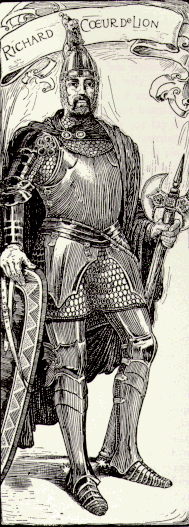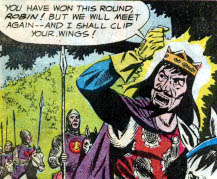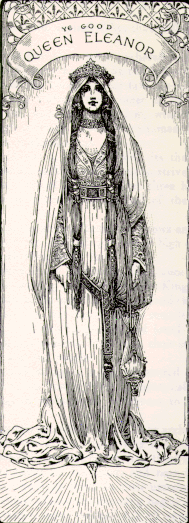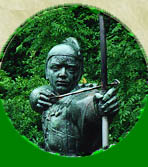
KINGS,
QUEENS AND PRINCES
By Allen W. Wright
As
an outlaw, Robin Hood is in direct opposition to the king's justice. The
Merry Men often feast on the deer which only the king is supposed to hunt.
In some ballads the king even pursues Robin Hood. So, it's somewhat surprising
that Robin Hood is often a strong supporter of the king, well ... some
of them.
In
a very early story, the king goes into the greenwood to find Robin Hood
and a knight that Robin has befriended. The king's men disguise themselves
as monks, and the king dresses like an abbot. The "monks" sing as they
ride through the greenwood which attracts the attention of a certain outlaw,
as planned.
Robin
shows up to rob the abbot and the monks. The king, disguised as an abbot,
tells Robin that he has just come from the king and presents the royal
seal. Robin declares he loves the king above all men. Even the mere mention
of the king is enough for Robin to only take half of the so-called abbot's
money.
 Robin
invites the disguised king to a grand feast of fat venison (deer meat),
white bread, red wine and brown ale. The Merry Men hold a pleasant archery
contest, but anyone who misses the target receives a buffet, a punch, from
Robin Hood. Eventually Robin's own arrow lands outside the garland target.
He begs the "abbot" to deliver the buffet. Robin
invites the disguised king to a grand feast of fat venison (deer meat),
white bread, red wine and brown ale. The Merry Men hold a pleasant archery
contest, but anyone who misses the target receives a buffet, a punch, from
Robin Hood. Eventually Robin's own arrow lands outside the garland target.
He begs the "abbot" to deliver the buffet.
The
abbot-king punches Robin and sends him flying. Robin is amazed at the abbot's
strength. But just then, the knight Robin befriended recognizes that the
abbot is truly the king.
The
outlaws submit to the king. The king asks Robin if he has any green clothing
that he can give the king. The kings' men dressed in the outlaw's colours
of lincoln green and march into Nottingham. The populace is afraid of the
visiting outlaws.
On
the way to Nottingham, Robin and the king shoot many times. Robin is often
on the receiving end of the king's buffets.
So,
the king pardons Robin Hood, and the former outlaw enters the king's service.
Many
modern stories end here, but in the original tale, Robin grows bored of
his courtly role. After 15 months in the king's service, he returns to
the forest to resume his life as an outlaw.
In
the early ballad, the king is called Edward and described as "our comely
king". Currently scholars think this king was Edward III. But many retellings
say the king was someone else. Early historians said that Robin Hood's adventures were set in the time Henry III or Edward I. There was a real person named Robin Hood who served Edward II, and that Edward travelled around England in a manner closely resembling the ballad.
Click here to read the ballads where Robin Hood meets the King. (King Edward in the medieval ballad A Gest of Robyn Hode and King Richard in the ballad The King's Disguise and Friendship with Robin Hood, a later version of the same story.)
But the
most popular choice in modern stories for the king Robin Hood befriended is Richard I, often
called the Lionheart or Coeur de Lion. And in those versions, Robin's encounter
with King Richard is often meshed with the story of the king's ransom.
While
on the Third Crusade, King Richard had deeply offended Duke Leopold of
Austria. In December of 1192, he made his way home through the lands of
the duke. King Richard was seized while in the disguise of a kitchen servant.
He was handed over to the duke and then later to Henry VI, the Holy Roman
Emperor and ruler of what is modern-day Germany. The emperor ransomed Richard
for 150,000 marks. Money that had to be raised from the English people.
In modern stories, such as the 1938 movie starring Errol Flynn, Robin Hood robs the rich in order to pay Richard's ransom.
Eventually, 100,000 marks were paid and Richard was let go.
 He
landed in Britain in late March 1194. While he was gone, his brother Count
(or Prince or Earl, depending on the title you want to use) John conspired
with the king of France. Count John was hoping to seize power for himself.
When Richard returned, John fled England. Most of John's supporters quickly
surrendered to Richard. Except those in Nottinghamshire (one of the counties Richard left under John's control in 1189). He
landed in Britain in late March 1194. While he was gone, his brother Count
(or Prince or Earl, depending on the title you want to use) John conspired
with the king of France. Count John was hoping to seize power for himself.
When Richard returned, John fled England. Most of John's supporters quickly
surrendered to Richard. Except those in Nottinghamshire (one of the counties Richard left under John's control in 1189).
Ranulf,
earl of Chester, and his brother-in-law, the Earl of Huntingdon (David
in real history, Robin Hood in some tales) led an attack on Nottingham.
King Richard joined them and seiged Nottingham Castle for two days. On
March 28, 1194, the castle garrison surrendered to the king. And the next
day, Richard went hunting in Sherwood Forest.
Many
tales weave Robin Hood into the events of March 1194. In the novel Ivanhoe, King Richard dons the disguise of the Black Knight in order to help Sir Wilfred of Ivanhoe and Locksley (Robin Hood). Robin may fight to
help Richard regain his throne, or maybe he meets Richard while the king
is hunting afterwards. Either way, Robin Hood is the sworn enemy of Prince
John.
But
times change. Richard soon left England to fight in Normandy. Some stories
have Robin Hood going with him. Richard died in 1199, and John became the
king of England.
John's
reign was a troubled one. He lost most of his lands in what would be modern-day
France. To fight the French, John had to raise the first income tax. Also,
the king had a feud with the archbishop of Canterbury. The pope imposed
an interdict on England -- virtually no church services were allowed in
England, and later the king was excommunicated. The barons rebelled against
King John and he had to sign the first draft of the charter which would
become known as Magna Carta. King John lost the crown jewels. And finally
John died from dysentry at Newark in Nottinghamshire. During his life, John often visited Nottinghamshire, and his favourite
hunting lodge was Clipstone in Sherwood. Various Robin Hood stories have the
outlaw involved in some or all of these events.
 Usually
Richard is seen as a good man, and a friend of the English. In reality,
Richard hated England. He visited England only twice in his reign. Richard
couldn't even speak English. John, on the other hand, knew England very
well and toured the country often. He frequently visited Nottingham. John
was cruel, lecherous and disloyal. But Richard had also rebelled against
his own father, Henry II. And while on Crusade, Richard had ordered the
execution of 2,600 prisoners at Acre. Sometimes Robin Hood was on the Crusades
with Richard. While he supported Richard, the events at Acre troubled Robin. Usually
Richard is seen as a good man, and a friend of the English. In reality,
Richard hated England. He visited England only twice in his reign. Richard
couldn't even speak English. John, on the other hand, knew England very
well and toured the country often. He frequently visited Nottingham. John
was cruel, lecherous and disloyal. But Richard had also rebelled against
his own father, Henry II. And while on Crusade, Richard had ordered the
execution of 2,600 prisoners at Acre. Sometimes Robin Hood was on the Crusades
with Richard. While he supported Richard, the events at Acre troubled Robin.
Robin
Hood was not only a supporter of the king. The queen of England was often
fond of him. In one ballad, Queen Catherine had Robin Hood shoot for her
in an archery tournament. This was probably Catherine of Aragon, Henry
VIII's first wife. But Henry and Catherine were born long after the legends
of Robin Hood. So, sometimes, the queen was made Eleanor of Aquitaine,
wife of Henry II and Richard and John's mother. Eleanor was a powerful
figure in British history for decades.
Eleanor
would be in her seventies when most Robin Hood stories are set. But some
tales have her madly in love with Robin Hood. King John was said to be
in love with Maid Marian. In one modern novel, Robin was the lover of King
Richard's queen, Berengaria. (Richard did not show much interest in his
wife. Many writers say King Richard was gay, although this is still a matter
of historical debate. But there are references that Richard did have an
illegitimate son named Philip of Cognac. This Philip teamed up with Robin
Hood's daughter, Gwyn, in the 2001 television movie Princess of Thieves.
However, unlike in the movie, Philip never became the king of England.)
At
one point in King John's reign, Eleanor was imprisoned by Arthur of Brittany,
her grandson and John's nephew. It's likely that John had Arthur murdered.
When Richard was on crusade, Arthur was his chosen successor. Some stories
have Robin helping the young Prince Arthur.
T.H. White's The Sword in the Stone (book one of The Once and Future King)
has Robin befriending another Prince Arthur -- a young man nicknamed
the Wart. But the Wart grew up to become King Arthur of Camelot. This story is a rarity, because although the Robin Hood story has been set in many different time periods, the reign of King Arthur was set centuries before the earliest Robin Hood story.
Where to go from here:
|

